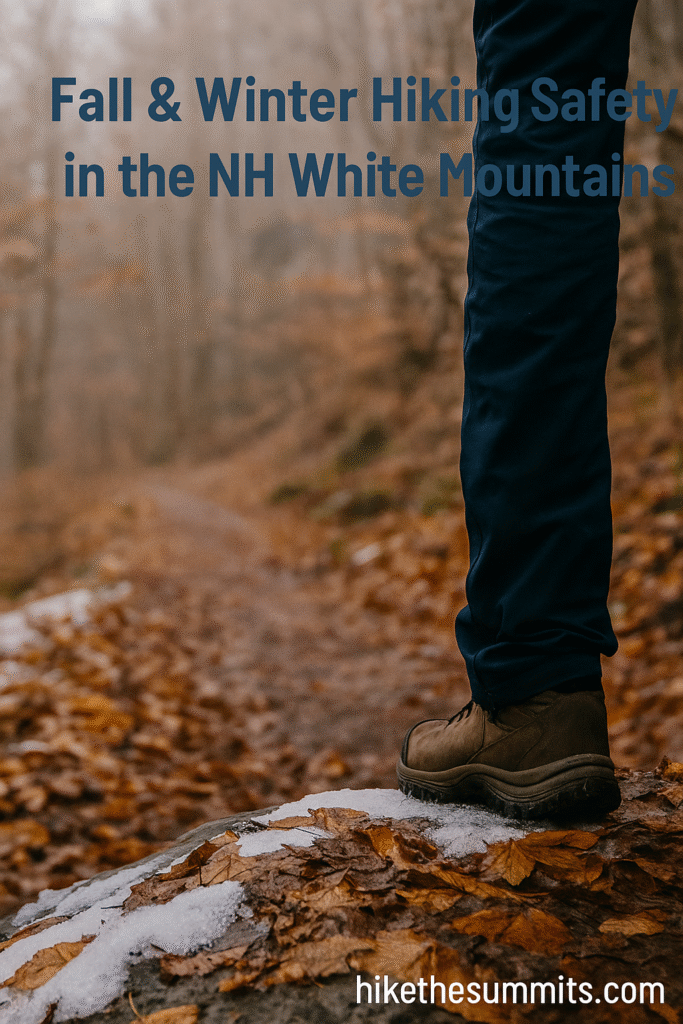🏔️ Fall & Winter Hiking Safety in the NH White Mountains
Don’t Let the Season Fool You: The Real Risks of Fall & Winter Hiking in the White Mountains
A Harsh Lesson from Mount Washington
This past weekend, more than two dozen hikers found themselves stranded on the summit of Mount Washington, caught off-guard by full winter-like conditions despite being in late fall. The high elevations had already chilled to temperatures near single digits, wind-chill dipping below zero, and a coating of snow turning the terrain treacherous. WMUR
Many of these hikers had reached the 6,288-foot peak wearing sneakers or light footwear, sweatpants or non-waterproof jackets, and assumed services and shelter would be available at the summit — assumptions that proved fatal. With the summit building closed for the season and the auto-road access shut, there was no place to warm up, rest or rely on rescue. The crew of the Mount Washington Cog Railway found them and brought them down in heated train cars. WMUR
According to staff, several of the hikers were showing the early signs of hypothermia — uncontrollable shivering, confusion, exhaustion — the result of mixing below-freezing temperatures, strong gusting winds and zero insulation or traction. “It’s literally life or death situation if they go up there unprepared,” declared an official from the New Hampshire Fish and Game Department. WMUR
This event underscores a vital point: at altitude in the White Mountains, fall can quickly be winter, and unprepared hikers aren’t just risking discomfort — they’re risking rescue, injury or worse.
“It’s a different world up there,” rescuers said. “Even when it looks calm in the valley, Mount Washington can turn dangerous in minutes.”
The Dangerous Illusion of Fall Hiking
What looks like a crisp, colorful day at the trailhead can quickly become an icy, fog-covered challenge higher up.
The White Mountains create microclimates — meaning conditions at 4,000 feet can differ by 30°F and include snow, even when the valleys are clear.
Common Traps That Catch Hikers Off Guard
-
🍁 Leaf-Covered Trails: Hide rocks, roots, and slick ice below.
-
🌒 Short Daylight Hours: Sunset can arrive before you’ve even started descending.
-
🌫️ Rapid Weather Shifts: Rain in the valley often means sleet or snow on the ridge.
-
📵 No Cell Service: You can’t count on GPS or calls for help above treeline.
-
🧭 Overconfidence: “It’s just a quick hike” are often the last famous words before trouble starts.
Gear Up: The 10 Essentials That Can Save You
Even if your hike is “just a few miles,” the White Mountains demand respect.
Bring gear that can get you through a night if things go wrong.
Top Gear Must-Haves
-
🗺️ Map and Compass: Batteries die, paper doesn’t.
-
🔦 Headlamp: Always carry one — darkness falls faster than you think.
-
🧥 Insulating Layers: Wool or synthetic; never cotton.
-
🧤 Gloves and Hat: Vital for heat retention even above freezing.
-
🧃 Extra Food and Water: Double what you think you’ll need.
-
🧰 Traction Devices: Micro-spikes or crampons for icy ledges.
-
🏕️ Emergency Blanket or Bivy: Hypothermia can set in within minutes.
-
🔋 Backup Battery: Cold drains phone batteries fast.
-
🧭 Navigation App + Paper Backup: Both are essential.
-
🥾 Waterproof Boots: Cold feet = poor decisions.
Plan Ahead or Pay the Price
Hiking in the fall and early winter isn’t about avoiding adventure — it’s about preparing for it intelligently.
Smart Safety Habits
-
🌤️ Check the Mount Washington Observatory Forecast before every trip.
-
⏰ Start early and set a turnaround time. If you’re not at your midpoint by noon — turn around.
-
🧑🤝🧑 Never hike alone in cold or changing conditions.
-
📍 Tell someone your route and expected return.
-
⚠️ Turn back when unsure. Pride doesn’t save lives — preparation does.
Why Fall and Winter Demand Respect
The Mount Washington rescue wasn’t an isolated case — it happens every season.
The transition months between fall and winter catch hikers off guard. Ice forms overnight, rivers rise with meltwater, and winds at the summit can reach hurricane strength.
Even veteran hikers can underestimate how fast a trail can turn into a survival test.
That’s why preparation isn’t optional — it’s the price of admission to these incredible landscapes.
Final Thoughts: Hike Smart, Hike Strong
The White Mountains reward those who respect them.
Whether you’re chasing a summit, photography, or the peace of solitude, remember — every year, rescues happen to people who thought it “wouldn’t happen to them.”
So before your next hike, stop and ask:
-
Am I ready for the worst-case scenario?
-
Do I have the right gear, knowledge, and mindset?
-
Do I truly respect the mountain I’m about to climb?
When you can confidently say “yes,” you’ll not only hike safer — you’ll hike stronger.
Because in the NH White Mountains, nature doesn’t negotiate — it expects you to be ready.

